Ted Williams: We can no longer 'stick our head in the sand' on rising crime
Fox News contributor and former D.C. homicide detective Ted Williams argues crime is not "under control" in the U.S.
Crime has skyrocketed across the country in the last couple of years, most notably violent crimes such as murders. As the country dealt with coronavirus lockdowns that upended society, the protests and riots that erupted in the summer of 2020 and a demoralized police force, data show prison populations also fell that year.
"Historic data clearly shows that if we can return to policies of consistent prosecution for low and high-level crimes and return the option of incarceration where it has been removed, we can hope for long-term ‘peace dividends,’" Manhattan Institute’s director of policing and public safety Hannah Meyers told Fox News Digital. "If our system can again both capture and incapacitate the concentrated but relatively tiny group of career criminals, while deterring other offending with the presence of consistent arrest and prosecution, we can hope to again reduce crime and minimize incarceration."
Data show that prison populations dropped in 2020 as federal and state prisons released inmates that year as the coronavirus raged, and government officials worried the close-quarters inmates share could exacerbate the spread.
Bureau of Justice Statistics (BJS) data found that 2020 marked the "largest single year decrease" for the number of people in prison "since the United States began tracking prisoner populations through the National Prisoner Statistics program in 1926." The data found that there was a 15% decrease across federal and state prisons in 2020 compared to 2019.
FBI'S NATIONAL CRIME DATA FOR 2021 INCOMPLETE, LACKS DATA FROM NEARLY 40% OF POLICE NATIONWIDE
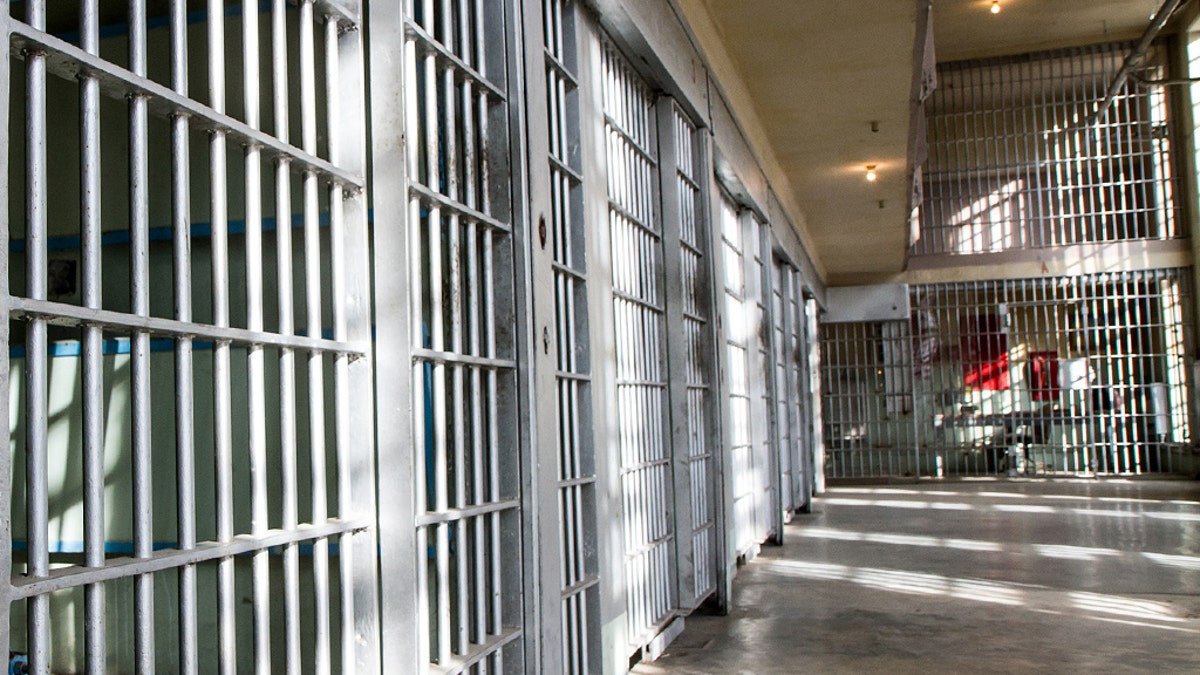
Data show that prison populations dropped in 2020. (iStock)
Meyers told Fox News Digital to take the 15% decrease figure with a "grain of salt," noting federal data on criminal justice has been spotty since the pandemic and that the BJS data relies on voluntary reporting from state departments of corrections and the Federal Bureau of Prisons.
"But that being said, certainly COVID led to an enormous decrease in incarceration both through decisions made by prosecutors and by judges," Meyers said.
Meyers noted that inmates held at state and federal prisons are serious and repeat offenders with high recidivism rates.
"So, releasing any proportion of this group from prison due to COVID will certainly have resulted in more crime being committed," she said.
Governors across the country announced early releases for prisoners across the country in 2020 as the pandemic raged, and officials worried that the lack of social distancing in prisons could worsen the spread of COVID and put inmates and prison employees at risk.
"To mitigate the effects of the spread of COVID-19 and protect the public health, welfare, and safety, especially of vulnerable workers or incarcerated persons at Maryland prisons, it is necessary and reasonable to implement protocols and procedures for transfer out of the State’s correctional institutions," an order from Maryland Gov. Larry Hogan, for example, read that year.
Similar to other states, inmates convicted of sexual assault and other violent crimes in Maryland were not eligible for early release.
MASSIVE INCREASE IN BLACK AMERICANS MURDERED WAS RESULT OF DEFUND POLICE MOVEMENT: EXPERTS
Fox News Digital spoke with retired NYPD officer and current John Jay adjunct lecturer Jillian Snider, who said many of the incarcerated individuals released due to COVID-19 in 2020 were older and fell outside of the age bracket of individuals who typically commit most crimes.
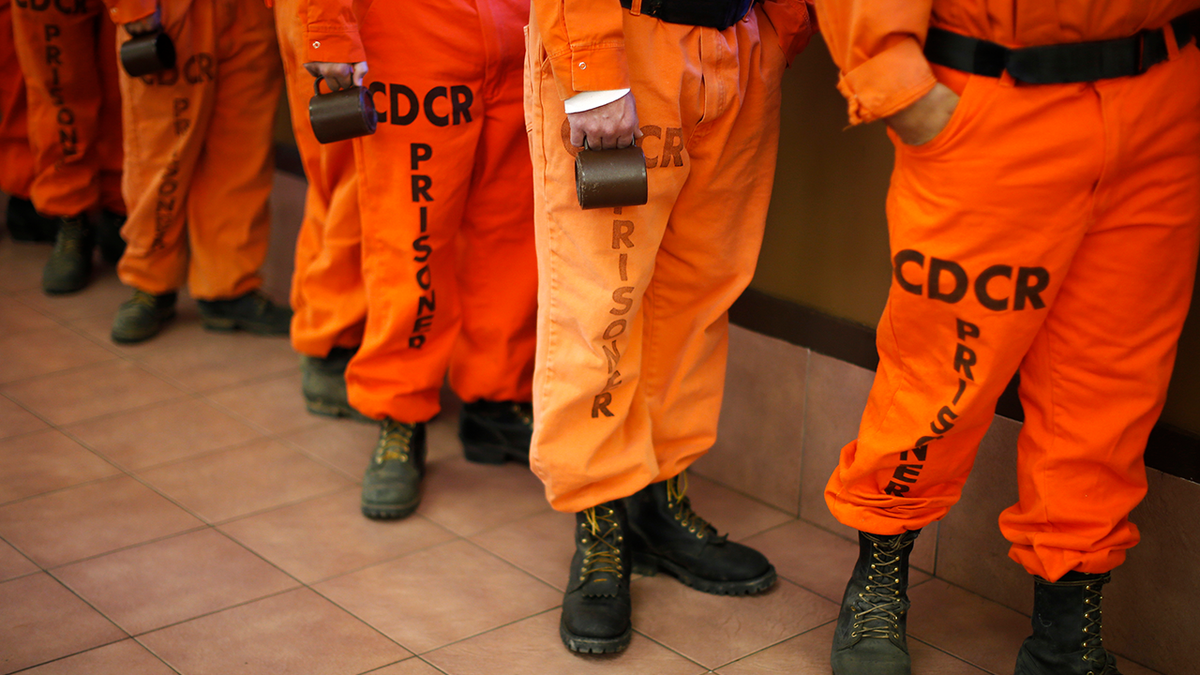
For health safety reasons, governors across the country announced early releases for prisoners in 2020 as the pandemic raged. (Reuters/Lucy Nicholson)
"If you look at crime statistics overall, the population that most likely commits violent crime is your 18- to 25-year-olds. Those are the ones who are most responsible for violent crime that we see. And that's been a number that's been so consistent … since criminology became studied in the field. And the population that we were leasing from prisons and jails were actually quite older than that," Snider said.
"I don't really think that there is a strong correlation between the releasing for COVID-related purposes and those individuals subsequently contributing to the current spike, because the data that we have thus far indicates that individuals released on COVID release actually re-offend and recidivate substantially less than individuals who are released through the traditional criminal justice processes," she added.
Violent crimes exploded across the U.S. in 2020, with murders increasing by nearly 30%, according to FBI data, marking the largest single-year increase in killings since the agency began tracking the crimes. The crime wave continued in 2021, with FBI data showing murders increased another 4.3%. The 2021 data released this month, however, is incomplete and lacks data from nearly 40% of police departments nationwide, including full reports from New York City and Los Angeles.
Experts who previously spoke to Fox News Digital pointed to a handful of variables that likely contributed to the crime spike that year, including the pandemic and its lockdowns disrupting everyday life, the protests and riots of 2020 following the killing of George Floyd, calls to defund the police, and the Ferguson effect — when police officers pull back as crime drastically increases.
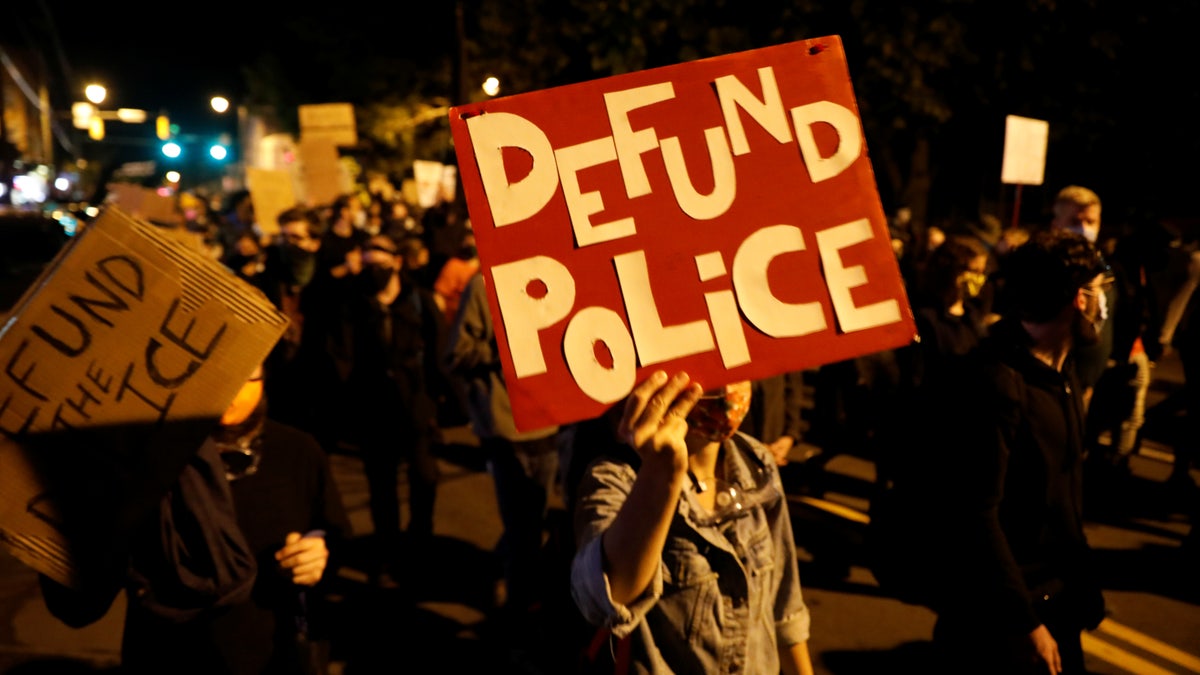
Demonstrators hold a sign reading "Defund the police" during a protest in Rochester, New York, on Sept. 6, 2020. (Reuters/Brendan McDermid)
TOM COTTON: DEMS 'WON'T TREAT CRIMINALS AS THE CRIMINALS THEY ARE'
Michael Rempel, director of the Data Collaborative for Justice at John Jay College of Criminal Justice, told Fox News Digital in a phone interview that as of right now, it is not possible to pinpoint if falling prison populations also added to the crime wave.
"I think the accurate answer is we don't know," Rempel said when asked if the BJS data showing a 15% drop in prison populations contributed to crime that year. "When there were so many disruptive events in 2020, that it is hard to pinpoint causality, and certainly no study produced thus far has done so vigorously."
He argued that in addition to the early release of some prisoners during the pandemic, stay-at-home orders in early 2020 prevented people from engaging in criminal behavior, which likely led to a fall in arrests and thus arrest rates and incarceration rates went down.
Meyers said multiple variables can add to a dip in prison populations, such as people not committing as many crimes, less space in prisons to hold inmates, and changes to prosecution policies, such as bail reform.
America began seeing changes to how suspects are prosecuted in 2017, according to Meyers, who said the policies would be "good [and] compassionate" if they did not increase crimes.
"However, data demonstrates that they have increased crime. For example, even before the newly passed SAFE-T legislation in Illinois, Chicago’s Chief Judge Timothy Evans instituted bail reform measures in 2017. Within 15 months, the number of felony defendants released without bond doubled, and the jail population fell from 7,443 to 6,000. And this is where we have seen so much fudging and obscuring of data in the last few years in an effort to prove (counter to reality!) that these policies haven’t hurt public safety," she wrote in an email to Fox News Digital.
Meyers added that case dismissals have also increased.
"And importantly, there are rising numbers of case dismissals in cities nationwide that spell lower jail populations and also more crime. Some of this is through specific policies enacted by local progressive prosecutors who, for instance, raise the threshold for shoplifting prosecution," Meyers said. "Or though essentially decriminalization, deciding that things like prostitution, resisting arrest, trespassing, etc. will not be prosecuted."
Dismissals have been compounded by "things like NYS’s discovery 'reform' statute that passed in 2019."
"It created such an impossibly large amount of material that prosecutors are now required to collect and hand over to defense attorneys that, for most cases, ADAs simply run out of the time they are legally allotted to bring cases, and these cases are automatically dismissed. Prosecutors therefore triage cases. Case dismissals in NYC rose from 44% in 2019 to 69% in 2021 (per NYS court data) largely because of this," Meyers wrote.
The Prison Policy, a Massachusetts-based think tank, reviewed 2020 prison data from the Bureau of Justice Statistics and reported this year that the drop in incarcerated populations was also attributable to a decrease in prison admissions.
NEW YORK TO SCRAP 'INMATE' IN FAVOR OF 'INCARCERATED INDIVIDUAL' IN STATE LAW
The data found a 40% drop in prison admissions and a 16% decrease in jail admissions nationwide in 2020 compared to 2019.
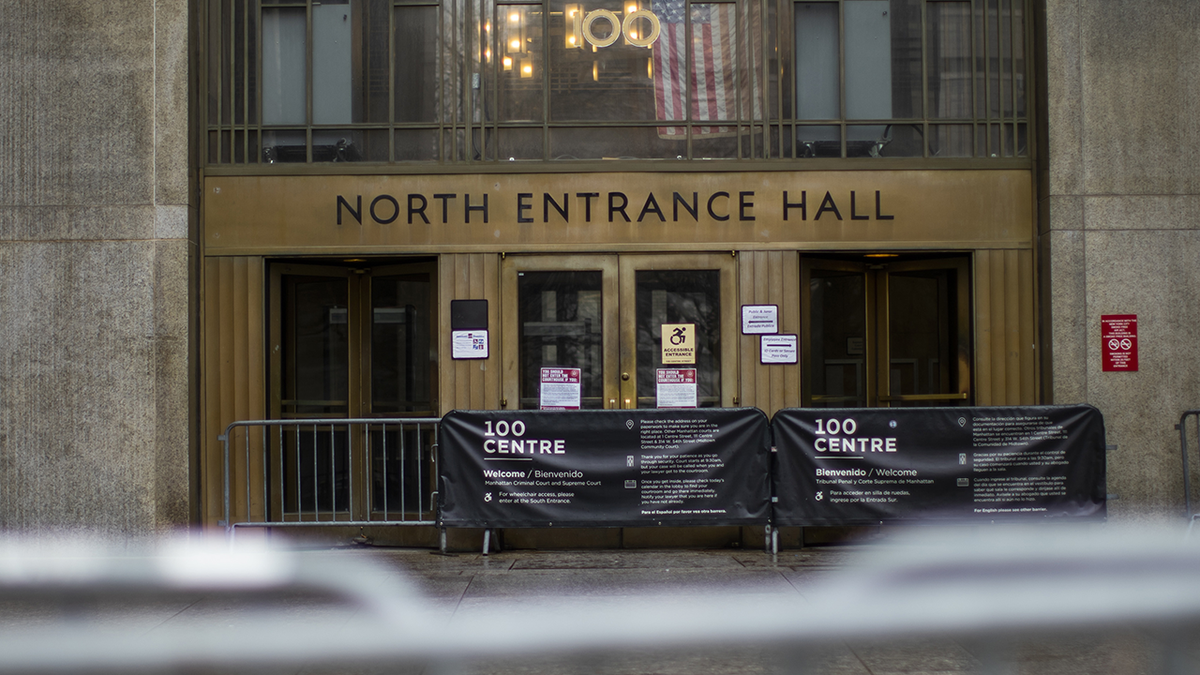
An entrance to the New York State Supreme Court building is closed during the outbreak of the COVID pandemic in New York on March 17, 2020. (Reuters/Eduardo Munoz)
Snider told Fox News Digital that another contributor likely added to the decrease in prison populations: a backlog at the courts in 2020.
"One thing that could possibly be a contributor and again, not a sole contributor by any means, is we saw such a backlog in the processing system, so not necessarily the individuals who were released for COVID, but individuals who were arrested and pending prosecution for so long, because we did see a real slow down amongst our trial processes because courts are closed," she said.
AMERICA'S MURDER RATE INCREASE IN 2020 HAS 'NO MODERN PRECEDENT,' CRIME ANALYST GROUP FINDS
Snider, who also serves as policy director for R Street’s Criminal Justice and Civil Liberties team, said data is "scarce" on such suspects and if they were subsequently convicted.
Snider, who said the defund the police movement "made people question the legitimacy of police," argued that cities should put more resources into proactive policing units to help curb crime.
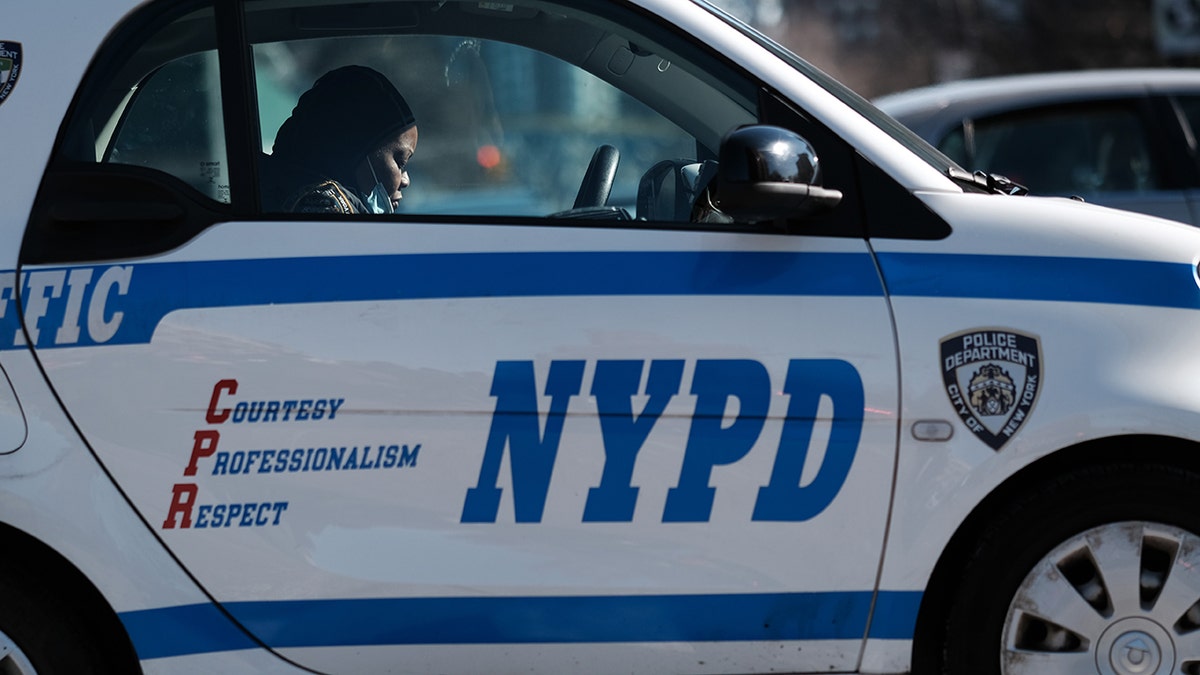
An NYPD officer sits in a marked vehicle. (Spencer Platt/Getty Images)
She spent a decade on the NYPD’s plainclothes unit and reflected on how some units, such as ones that aren’t in marked cop cars and don’t respond to 911 calls for service, are able to dedicate efforts to knowing their community.
"They were basically doing research on who in this community is the one that is most likely to commit this violent act or who has a history of or who's on parole or probation … they were out there gathering intelligence in the field," she said of proactive policing. "And they were seeking out those alpha male targets, the ones that are most likely going to engage in violent crime."
Meyers noted that at least for now, more people "absolutely" need to be incarcerated to curb crime.
CLICK HERE TO GET THE FOX NEWS APP
"Crime tends always to be concentrated among a very few, repeat offenders (and in specific locations). Unless we return to incapacitating those individuals in jails and prisons, they will, without question, keep offending — which further creates an atmosphere of crime-without-consequence that encourages others to offend as well," she said.


